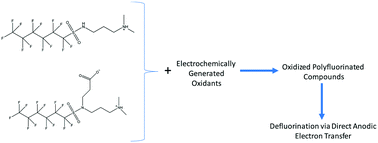Electrochemical treatment of poly- and perfluoroalkyl substances in brines†
Abstract
Bench-scale experiments were performed to evaluate the electrochemical oxidation, via direct anodic oxidation and indirect oxidation from salt-derived species, of diluted aqueous film forming foam (AFFF) in brine solutions to mimic anion exchange resin regenerant solutions that are loaded with poly- and perfluoroalkyl substances (PFASs). Results showed that initial transformations of the polyfluorinated compounds, which accounted for approximately 45% of the organic fluorine in the initial mixtures, occurred primarily via an indirect oxidation pathway that targeted the non-fluorinated head groups. Depending on the brine solution, this indirect oxidation likely occurred via hydroxyl radical production or salt-derived oxidants (e.g., SO4˙− derived from anodic oxidation of sulfate). However, perfluoroalkyl acid (PFAA) transformation and the overall rate of defluorination were controlled via a combination of direct and indirect electron transfer. Chloride levels (>0.2% by weight) and the presence of 100 mM of the radical scavenger tert-butyl alcohol substantially reduced pseudo first order defluorination rate constants by up to 80%. Evaluation of fluorine mass balances (via fluoride generation and PFAS levels) suggested that up to approximately 41% (based on a fluorine mass balance) electrochemically transformed intermediate products were not identified under some conditions. Thus, evaluating electrochemical treatment effectiveness solely on the disappearance of PFAAs and other suspect analytes described in current analytical libraries could substantially underestimate the PFAS mass remaining in AFFF-impacted waters.



 Please wait while we load your content...
Please wait while we load your content...